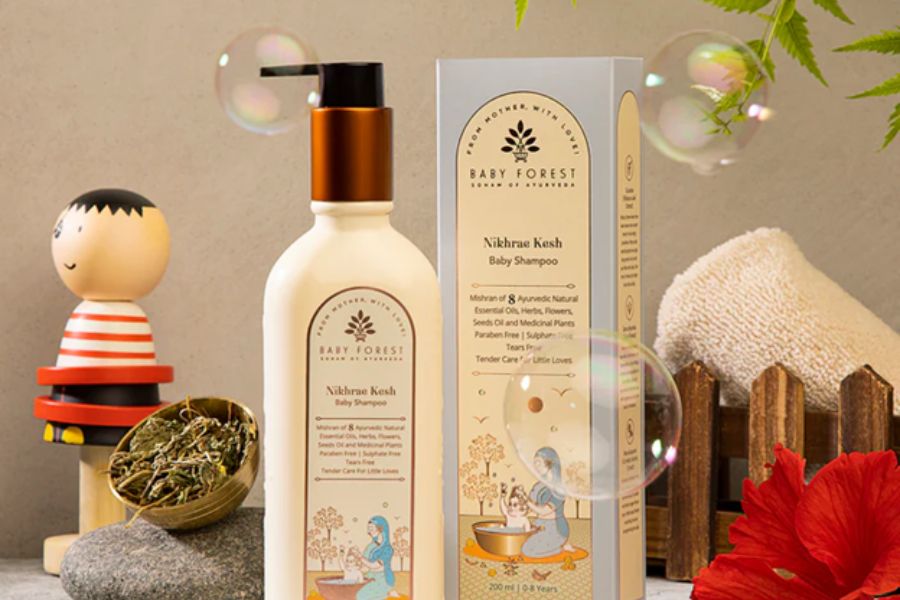When washing your little one's delicate hair and scalp, choosing the right baby shampoo isn't just about getting them clean—it's about keeping them happy and healthy, too! Baby shampoos are carefully crafted to be gentle, without harsh chemicals that can irritate your baby's delicate skin. If you're searching for the safest options, organic baby shampoos packed with natural ingredients are usually your best bet. Ready to dive in? Let's walk through what ingredients to look for in baby shampoos and which ones to avoid, ensuring your baby's hair is not only clean but also soft, shiny, and healthy.
Best Ingredients in a Baby Shampoo
1. Hibiscus Leaf Extract (Gudahal Ke Patte): Loaded with vitamins and amino acids, hibiscus leaf extract unequivocally promotes hair growth and fortifies hair roots. It is also known for its natural conditioning properties, making the hair soft and smooth.
2. Green Gram Extract (Mudga): This ingredient is traditionally used in hair care for its cleansing and refreshing properties without stripping natural oils. Green grams are abundant in essential nutrients that effectively nourish the scalp and actively promote healthy hair growth.
3. Centella Asiatica Extract (Mandukaparni): Centella Asiatica is renowned for its healing properties and is proven to enhance circulation, thus significantly improving the delivery of oxygen and nutrients to the hair roots. This herb is excellent for maintaining a healthy scalp and enhancing hair texture.
4. Sage Extract (Samudraphala): Sage is incredibly beneficial because of its powerful antioxidant properties, which effectively shield the scalp and hair from environmental stressors. It also aids in balancing scalp oils, making it suitable for babies who may have dry or flaky scalps.
5. Aloe Vera (Ghrit Kumari): Aloe Vera is renowned for its moisturizing and soothing properties. This soothes the scalp, reduces itchiness, and conditions the hair, leaving it shiny and smooth.
6. Coconut Oil: Coconut oil is a fantastic ingredient for baby shampoos due to its ability to moisturize and protect the hair. It goes deep into the hair and makes it healthier by reducing breakage and improving its condition.
7. Neem Extract: Neem possesses natural antibacterial properties, which help maintain a healthy, infection-free scalp, particularly useful for preventing cradle cap.
8. Sesame Seed Extract: Rich in nourishing fatty acids, sesame seed extract is excellent for its hydrating and healing properties. It helps in moisturizing the scalp and protects it from dryness while strengthening the hair.
Ingredients to Avoid in Baby Shampoo
While knowing what to look for is important, knowing what to avoid is equally crucial for the safety of your baby:
1. Sulfates (like SLS/SLES): Using harsh shampoos will strip your scalp of its natural oils, leading to dryness and irritation, even though they create lather in your hair.
2. Parabens: Often used as preservatives in cosmetic products, parabens can disrupt hormone function, which is especially risky for babies.
3. Phthalates: These chemicals are used to make fragrances last longer but are linked to hormonal disruptions and developmental issues.
4. Formaldehyde and formaldehyde donors: These preservatives release small amounts of formaldehyde, which is a known carcinogen.
5. Synthetic Fragrances and Colors: These can cause allergies and skin irritation, so it's best to choose baby shampoos that are fragrance-free or scented with natural essential oils.
6. Propylene Glycol: Often used as a skin-conditioning agent, it can be an irritant and cause dermatitis.
How to Choose the Right Baby Shampoo for Your Child?
Choosing the right baby shampoo for your child involves careful consideration to ensure that the product is gentle, safe, and effective. Start by looking for shampoos that are specifically formulated for babies, as these are typically milder than regular shampoos. Opt for products labelled as "tear-free" to minimize eye irritation during bath time. It's important to choose shampoos free from harsh chemicals like sulfates, parabens, phthalates, and synthetic fragrances, as these can harm a baby's sensitive skin and scalp.
Additionally, consider the specific needs of your child's hair and scalp. For example, if your baby has dry skin or cradle cap, seek shampoos with natural moisturizing and soothing ingredients such as aloe vera, coconut oil, or oat extract. For normal skin, shampoos with mild cleansers and natural conditioners like chamomile or calendula are excellent choices. If you live in places with warm, dry climates it’s especially important to look for shampoos with hydrating ingredients such as aloe vera and coconut oil. These ingredients help keep your baby’s scalp moisturized and prevent dryness that can be common in such environments. Always check the ingredients list to make sure the shampoo is hypoallergenic and made with natural or organic ingredients. This will provide gentle care for your baby's delicate hair and scalp.
Conclusion
Choosing the right baby shampoo is vital for maintaining your baby's hair health and scalp hygiene. Opt for organic, natural baby products that contain beneficial extracts like hibiscus, green gram, and Centella Asiatica, which nurture and protect your baby's delicate scalp while avoiding harmful chemicals that could cause irritation or harm. By being informed about the ingredients in your baby's shampoo, you can ensure that you are providing the best care, keeping their hair soft, shiny, and strong. Remember, a little research goes a long way in ensuring the safety and health of your precious little one.
This is a PR article which has been published as received without any editorial enhancement, or modification.. The Telegraph Online does not endorse or guarantee the accuracy, reliability, or completeness of any information presented in the article. The organization is not responsible for any errors or omissions in the content or for any losses, damages, or injuries arising from the use of the information provided in the article.










